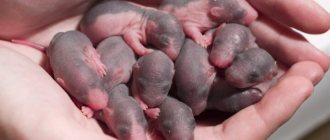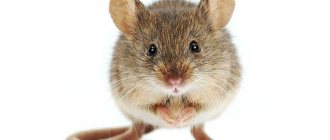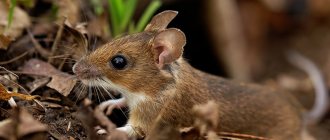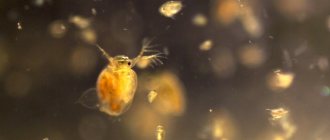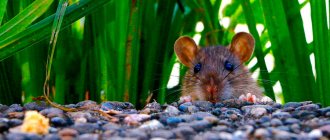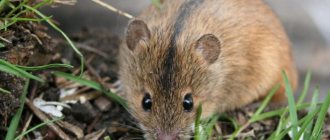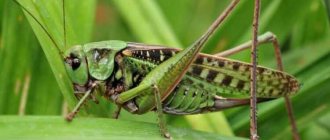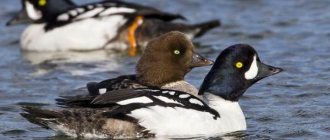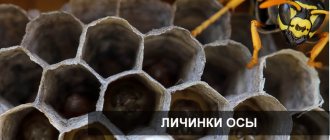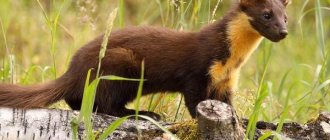Mice and rats belong to the group of cosmopolitan species, which implies a wide distribution area of these mammals, which live in all corners of the planet, with the exception of mountainous areas and zones of the Far North.
Both of these species are characterized as synanthropic, that is, even wild members of the family live near human habitation, which facilitates access to food sources. Most people believe that the only difference between rats and mice is the difference in size. This is true, rats are large, but there are other differences that are worth considering in detail.
THE SMALLEST MOUSE
The little mouse is the smallest rodent in the world, and together with the pygmy shrew and the tiny shrew, it is the smallest mammal on the planet. The body length of this mouse is only 11-13 cm, and almost half of it is a long tail. The weight of an adult male is no more than 16 g, a newborn mouse is slightly less than 1 g. The flat muzzle with short ears, together with the bright reddish fur of the back and sides of the body, distinguishes the baby mouse well from other small rodents.
Along river valleys, this species penetrates far to the north - to the Polar Urals and Yakutia, and in the Central Caucasus it lives in alpine and subalpine meadows at an altitude of up to 2200 m. The little mouse lives primarily in wet meadows near rivers, along the edges of forests, and sometimes settles in fields, rice paddies and hayfields. It is extremely difficult to see and observe her. And the point is not only in its small size, but also in the amazing ability of this animal to hide and hide its presence. More often, a baby mouse is seen by chance, having scared it away from the nest, or in winter, when the animals gather in groups.
How is it different from a mouse?
Newborn rodents of different species are often confused with each other. The little ones are very similar to each other, but there are still many differences between them. An attentive person will quickly determine by the appearance of the babies exactly whose nest he was lucky enough to discover.
Rat cubs from mice are distinguished according to the following criteria:
- Size. The body of a newborn baby rat will be longer than that of a mouse.
- Muzzle. In a baby rat, it seems to be chopped off and has bulging eyes covered with skin.
- Ears. In the vole they are round and large.
- Tail. Mice have a long and thin tail. It is equal to the length of their body.
The baby rats in the photo will be larger in size. They are slightly thicker and darker than a newborn vole.
NEST ON STILTS
In summer, the baby mouse builds a spherical nest from blades of grass, slightly larger than a tennis ball, securing it between the long stems of plants. As a result, such a ball hangs above the ground at a height of up to 130 cm, although sometimes it can be located on the ground. The outer layer of the nest consists of woven large parts of plants, which are most numerous in the meadow, while the inner lining consists of smaller and softer materials. Such a dwelling is intended primarily for breeding offspring. From May to October, a baby mouse has 2 to 3 litters, consisting of 5-8, or even 12 pups. In England, for example, where climatic conditions are milder, animals breed even in December. At the same time, a separate nest is built for each litter, which helps mice avoid annoying parasites.
The nest does not have a special entrance, and the female, each time she climbs into it, makes the passage again. When leaving the nest, she always closes the hole. In this way, she improves camouflage and reduces the risk that some predator will discover her offspring. At the same time, on the territory of the mouse pair there may be one or more more simply arranged residential ball-houses, which the parents use for relaxation and shelter.
Mice develop very quickly and reach sexual maturity by about 40 days of age, and if conditions are favorable, they themselves have offspring in the same year.
Amazing moments from the life of rodents
Facts about rats Interesting facts about rats are regularly published in the press around the world. An experiment was carried out. Several wild rats from the same family were placed in a glass container. One of them was placed in another box side by side. They threw food at her, but when the animal began to eat, her other relatives were shocked. The animal saw all this suffering through the glass. As a result, 90% of individuals chose their own death and refused to eat.
A lot of interesting:
- From whom rats originated, there are many versions. Some believe that these are space aliens transmitting signals to distant worlds. The fact confirms that animals arose 48 million years earlier than humans. But they could have happened in the process of evolution.
- The joints of rats have the same structure as human ones, with an equal number of bones.
- Gray rats or pasyuki develop speeds of up to 10 km per hour, jump in a calm state up to 80 cm in height, and when aggressive - up to 200 cm in height and length. Pasyuk can swim on water for 3 days. The recorded record is a distance of 30 km. If there is no way to get to land, he will drown.
- Rats squeak in the ultrasonic range, remaining invisible to predators. They communicate with each other, warn about danger, about finding food.
- The rat is the only mammal that can laugh. Scientists recorded the animal's smile while showing a funny video. It has been established that these rodents dream.
- During a mass extinction event, rats are not in danger of becoming extinct. The number is regulated by nature due to the increase in rat pups in one litter. A pair of rats can reproduce about 2 thousand rat pups in a year, creating their own numerous colony with a leader and several dominant females.
- There is a version that rats caused the extinction of dinosaurs. They regularly sucked out the eggs, preventing the young from developing. The number of rats in the world is such that there are 2 rodents per person. In those days the colonies were just as numerous.
- In a year, one individual is capable of devouring 12 kg of various food, the damage from spoilage of supplies and containers is several times greater.
You can endlessly cite interesting facts from the life of rats. For these reasons, these animals are preferred to dogs, cats, and kept as pets. Translated from Chinese, the word “rat” means happiness.
FIGHTING ANIMAL
The baby mouse is active all day, every three hours a short sleep and feeding alternate each other. The animals are very sensitive to overheating and try to avoid direct sunlight, so in summer they are usually nocturnal, while in winter they are more active during the day. To avoid enemies, the little mouse moves slowly and carefully, often freezing behind the stem of a plant. If danger persists, a wary rodent may even plummet downwards, hiding in the shadows on the ground.
The baby mouse feeds on all available seeds and fruits, and in the fall it sometimes makes small reserves of grain, which will come in handy in the coldest weather. After all, animals do not hibernate during the winter. In search of food, they scour under the snow, but not far from their “winter apartment.” This is simply a constructed hole or a ground shelter - among dead wood, under stacks and haystacks. If the winter is very harsh, the animals move into human buildings.
In the cold season, males and females live separately, uniting in pairs only to breed offspring, but in the most favorable places for wintering, for example, in stacks or granaries, they form clusters of up to 5 thousand individuals.
Methods of disposal
To prevent the settlement of large colonies of rodents, it is necessary to promptly remove garbage and plant remains from the area.
It is advisable to dig up the soil by the time autumn approaches. If mice have already settled on the site, then in order to rid your home and storage areas of these rodents, you can go in two ways. The first of them is more humane and is based on the intolerance of some odors by these mice. If you place some plants in the pest holes, you can survive the small pests without harming them. Such plants are:
- elder;
- garlic;
- mint;
- sagebrush;
- black root;
- imperial hazel grouse.
You can also use chemicals, such as kerosene or ammonia. They should not be poured into the hole from the bottle. Simply soak a piece of cotton wool in the liquid and place it in the rodent’s home. He will leave him and never return.
If humane methods for one reason or another do not bring the desired result, then you can take a more cruel route, using resources such as:
- mousetraps;
- ultrasonic repellent devices;
- I;
- ash;
- cats.
Mousetraps and cats are commonplace, but this cannot be said about ultrasonic repellers. They can be easily purchased in specialized stores. The principle of operation is to produce sounds that are inaudible to humans, but painful to the sensitive ears of rodents. The voles will not be able to tolerate it and will leave the area. For certain reasons, they also try to avoid ash.
The field mouse is quite cute in appearance, you can see this just by looking at its photo. But its pleasant appearance absolutely does not justify the irreparable harm it causes to agriculture. Therefore, one cannot but rejoice at the fact that although it appears easily, getting rid of it will not be particularly difficult.
A SHORT, HAZARDOUS LIFE
In nature, the lifespan of baby mice is very short - up to a maximum of 1.5 years, but usually no more than 6 months. According to European scientists, 95% of all animals in the population die in winter. The main causes of mortality are cold or wet weather, sudden frosts and predators such as weasels, stoats, foxes, cats, owls and crows. Moreover, in captivity, animals can live up to 5 years. Peaks in the baby mouse population usually occur every 3 years, after which there is a gradual decline followed by growth. In nature, populations of this rodent are characterized by an extremely high reproduction rate, but at the same time very low survival rate. The baby mouse in some European countries is classified as a species that requires protection due to the gradual decline in their numbers. As the main threats to this species, researchers note the increasing intensification of agriculture and, as a result, the destruction of potential habitats, as well as the generally poor knowledge of the ecology of this species.
Reproduction
Baby mice breed three to four times a year and, on average, give birth to five to six cubs at a time, but there are cases where a female gave birth to eleven children at once. Newborn babies weigh less than one gram and are born blind, deaf and bald. But already on the eighth day they begin to see clearly, and at the age of two months they become completely independent and ready to reproduce. If the reproduction process occurs at home, then during this period it is better to transplant them into another cage, since the mother begins to prepare for the next birth, and the already adult cubs will bring her significant discomfort.
LITTLE MOUSE IN THE FOOD CHAIN
The main food of the baby mouse is the seeds of various herbs, primarily cereals and legumes, tree fruits and grains of cultivated plants. In summer, animals also readily eat small insects such as butterflies, moths and grasshoppers, and their larvae.
NUTRITION OF THE BABY MOUSE
CHINA MEADOW
In the second half of June, in sparse mixed and birch forests, on forest edges and slopes, and in steppe meadows, the herbaceous perennial blooms - meadow chin. On tall, up to 1 m, thin stems, among many small leaves and tendrils, clusters of bright yellow moth flowers light up. Soon they will turn into beans. This plant from the legume family is loved by sheep, horses, and geese. Nina meadow, like many other legumes, is very nutritious: it contains a lot of ascorbic acid, carotene and vitamin P, and microelements. And, despite the bitter taste, the little mouse gladly includes it in its diet.
OATS
The baby mouse's obligatory dish is grains of cultivated cereals. For example, oats. The fruits of this plant are distinguished by the optimal percentage of carbohydrates, proteins, fats and B complex vitamins. Oats contain the protein necessary for the body to grow and repair tissues. Soluble fiber lowers blood cholesterol levels, protecting the cardiovascular system. Vitamins and minerals are involved in important metabolic processes in the body. It is no coincidence that people use oats as a dietary product and include them in the diet of those recovering. The mouse, although it does not know about the chemical composition of the cereal, appreciates it, perhaps, more than a person.
ENEMIES OF LITTLE MICE
LASKA
This smallest representative of mustelids is a formidable enemy for the tiny mouse. Agile and agile, the weasel runs quickly and crawls through the narrowest cracks and holes. This bloodthirsty animal sometimes stores up to 30 voles and mice in reserve! There is no escape for small rodents either on the surface or in the burrow from this predator. She makes several holes in bird eggs and sucks out the contents. 6 In search of food, the hardy animal runs up to 2 km per day. The weasel moves skillfully under the snow and swims well. This animal is distinguished by its courage. Thus, the weasel desperately defends its nest, no matter how great the danger. Sometimes a weasel even copes with a bird of prey that attacks it itself, gnawing its throat in flight.
COMMON FOX
Mice and voles make up about three-quarters of this predator's diet. There is even a special term for fox hunting for small rodents - mouse hunting. The fox's ability to change its diet depending on its habitat is amazing. In the southern regions of Europe it eats reptiles, in the Far East, near rivers, salmon fish, and near the seashore, sea debris (from mollusks to large mammals). In the taiga it attacks large birds and even young ungulates. She deftly grabs beetles flying by, and after the rain she collects earthworms. Be sure to add fruits and berries to meat foods. But the hare becomes prey only during the period of lack of food; the fox very rarely chases after it.
GRAY OWL
This is one of the most common owls in temperate latitudes. She prefers to forage in forest clearings, forest edges and floodplain habitats, primarily at twilight and at night. The main food of owls is small mammals, which the owl detects with the help of exceptionally sensitive hearing. Moreover, in absolute darkness, the error when throwing for prey is no more than one degree.
Similarity in appearance
Mice and rats, despite belonging to separate species, have a number of similar characteristics.
These include:
- Lack of thick hair on the tail. The exception is the black rat; the tail of this animal is covered with thick hair.
- Round eyes black.
- Presence of sharp anterior incisors.
Similarities can also be identified according to the characteristics of behavior, nutrition, and lifestyle in general.
INTERESTING FACTS
In nature, during years of high numbers, the baby mouse can harm grain crops. In addition, it is a natural carrier of pathogens of various diseases: tick-borne encephalitis, tularemia, leptospirosis, etc.
Unlike many other mice, this animal is very convenient and pleasant to keep at home. The excretions of these mice have almost no specific odor. The animals are a little shy, are easily tamed and are not picky about food, and observing their behavior can bring a lot of joy and vivid impressions to an attentive naturalist.
Habitat
This rodent can take root almost anywhere: in a field, in a meadow, in a forest. The only criterion for the area inhabited by baby mice is the abundance of grass, and it is desirable that it be tall. In it, a mouse can build a nest and feed itself. The nests of these animals are spherical and look like a real work of art. The little ones love to climb the stems of plants, which is not particularly difficult for them, because they weigh very little, and they also have a very tenacious tail.
Ways to fight and protect
The main difficulty in the fight against field mice is that they live in places hidden from human eyes. This means that catching or poisoning them is quite problematic. Therefore, the primary task in the fight against voles is the need to find and destroy their housing. You can do this in the following ways.
We drive mice away from the territory
First of all, you need to try to drive rodents out of the area:
- Mow tall grass, remove dry leaves and weeds. You also need to get rid of branches and piles of plant debris. All of these are great places to build burrows.
- Fruits that have fallen from the tree should not be left on the site, as they are an easily accessible source of food.
- Digging up the area can help get rid of holes and underground passages.
- To prevent rodents from damaging fruit trees, a fine mesh net is dug into the ground around the trunks. The same can be done around the perimeter of the entire site.
We use repellers
The use of special repellent devices can speed up the process of expelling voles from your territory. They are installed around the perimeter of the site and provide protection from moisture.
We use mousetraps
Ordinary mousetraps can also help in the fight against mice. Experienced gardeners recommend installing these devices on the site in early spring and late autumn, since it is at this time that mice reproduce most actively. To prevent harm to pets, mouse traps can be covered with a box; this will not stop mice in pursuit of the bait.
We use poisons
At the end of winter and beginning of spring, the use of poisons is very effective. At this time, mice are hungry and not very picky about food. Poisons are placed directly in burrows.
Snake Tetracheilostoma carlae
The snake Tetracheilostoma carlae is the shortest snake found in the Caribbean.
Blair Hedges, Pennsylvania State University
This baby grows to only 100-104 mm in length and can easily be confused with an earthworm. Likes to hide under stones and also in the soil. It feeds on termites, ant eggs and other small insects. Not poisonous.
In order to survive, many creatures during evolution have to take on the most bizarre shapes and unusual sizes. The most striking proof that nature has prepared many surprises for us are the miniature animals of our planet.
Younger age
Starting from the fourth day, the development of little rat pups occurs at a rapid pace.
- 4th day the ears open, the pups begin to distinguish sounds and hear rustling sounds;
- 6th body is covered with soft dark fluff;
- On the 8th, teeth emerge, except for the main incisors.
After 10 days of life, the pups become active. They crawl well and master the terrain. If these are pets, they should be handled more often so that the animals grow up tame. However, during the game they should not be left unattended, since coordination of movements is not yet developed, the kids can fall to the floor from a table, any height.
Fish Paedocypris progenetica
The smallest aquatic animal. The fish Paedocypris progenetica is recognized as the smallest inhabitant of water bodies. It can be found in sewage streams and peat swamps in Indonesia.
The largest are the females of these fish, but they are also small - 10.3 mm in length. The smallest officially recorded length of this fish is 7.9 mm. Interestingly, these little ones belong to one of the large carp families!
Offspring
The health of the offspring depends on the quality of the female’s nutrition during pregnancy and the interval between matings. At birth, babies do not see or hear anything, they have no fur, but they have a good appetite. Each weighs no more than 1.5 g.
After a week, you can see grown hair on the animals’ bodies, and the first incisors of the lower jaw appear in the mouth. By 14 days of age, a baby mouse can already see and hear.
Females have noticeable nipples from childhood. In males, the testicles move from the abdominal cavity to the scrotum only in the second week. It is after this that the gender of the offspring can be understood.
A wild litter is not the same as that of a domestic mouse. It develops faster. If indoor rodents are picked up prematurely, the mother may abandon them.
Therefore, offspring can be accustomed to human attention after three weeks, when rodents leave the nest in search of new horizons.
Month-old indoor animals can be given to other people for new families. At this age, they are unlikely to eat their mother's milk. And they switch to adult food and become completely independent.
The mouse has given birth! What to do ?
Microfrogs Paedophryne
The smallest land animal. Microfrogs (lat. Paedophryne) - this small frog belongs to the family of narrow-mouthed frogs, or microfrogs.
flickr/Yvonne Laurence
It is considered the smallest in the world, its length does not exceed 7.7 mm, but sometimes it grows up to 11.3 mm. This little one was recently discovered, it was found in Papua New Guinea. The females of these amphibians are slightly larger than the males. Thanks to its brown color, this frog is invisible neither on the ground, nor among the foliage, nor on tree trunks.
Pregnancy
Pregnancy in mice is indicated by the absence of another estrus. An attentive owner will definitely notice changes in the behavior of the rodent while bearing cubs. Some animals become calmer, others, on the contrary, become irritable or even aggressive.
Until almost the middle of pregnancy, it is impossible to determine that the mouse is carrying cubs in the womb. The rodent looks normal except for the fact that its appetite is slightly increased. The mouse walks smoothly and carefully. Motor activity decreases slightly. In the second half of the term, the abdomen increases in size. Shortly before birth, you can feel the fruit inside.
During pregnancy, mice experience toxicosis:
- the female loses her appetite;
- looks lethargic;
- eyelids drooping;
- drool flows from the mouth;
- sometimes there are cramps.
Important! Toxicosis cannot be treated. A mouse that bears offspring needs to be provided with complete rest, since the main cause of this pathology is stress.
How many babies does a mouse carry?
The gestation period in mice lasts 18-24 days. The duration of gestation depends on how many cubs are in the womb. The greater the number of pups, the faster the birth will begin. The length of gestation can also be affected by the conditions under which the rodent is kept.
In a favorable environment and with good nutrition, the mouse waits 20-22 days for the birth of its cubs.
Caring for a pregnant mouse
From the home of the mouse that carries the cubs, everything unnecessary is removed - the wheel, the tunnels. Access to the second level is limited.
About 10-12 days before giving birth, the mouse begins to build a nest. To do this, she will need pieces of fabric, napkins and paper. The rodent carries all this into the house. If until now the animal did not have a private place in the cage, the owner must equip it. It is there that the mouse gives birth to her pups and takes care of them.
The temperature and humidity in the room should remain approximately the same level. Do not disturb the mouse unnecessarily. Even cleaning the cage during pregnancy is done less often than usual. No noise or contact with other animals is allowed.
Despite the fact that the mouse needs rest, motor activity is not limited. The expectant mother is not prohibited from walking outside the cage, but only under the supervision of the owner.
5-6 days before the birth of the cubs, you need to do a general cleaning of the mouse’s home. All equipment and trays are thoroughly washed and disinfected with boiling water. It is better not to touch the nest if the female has already managed to equip it. If the male was still in the cage with the pregnant mouse, he should be removed.
If this is not done, he can impregnate the female within a few hours after birth.
Feeding
In the first half of the gestation period, the mouse's daily food intake is increased by a third, and in the second half, it is doubled. In addition to the grain mixture, the female should receive vegetables, fruits and fresh herbs. Since calcium and protein are needed for the development of cubs, low-fat cottage cheese, eggs and milk are introduced into the diet.
A glucose solution is added to drinking water. There should be a lick stone in the cage, with the help of which the mouse satisfies the increased need for minerals.
hummingbird bee
The smallest bird. The bee hummingbird (lat. Mellisuga helenae) is the smallest among birds.
flickr/dermoidhome
It was discovered in 1844 in Cuba by Juan Cristobal. Its weight is only 1.6-2 g, and its body length is 5-7 cm. It feeds, like all hummingbirds, on the nectar of flowers. Interestingly, the heart of this miniature bird beats at a frequency of 300-500 beats per minute.
Denis's seahorse
Denis's seahorse (lat. Hippocampus denise) is another little one and a master of camouflage. It lives in the warm waters of the western Pacific Ocean at a depth of about 16-90 m.
flickr/pats0n
One can only wonder how such a tiny creature, whose length does not exceed 1 cm, manages to survive among the cruel world of marine life. But it turns out that it is possible to survive: it perfectly camouflages itself as gorgonians or the corals in which they live, painting its body orange or yellow.
